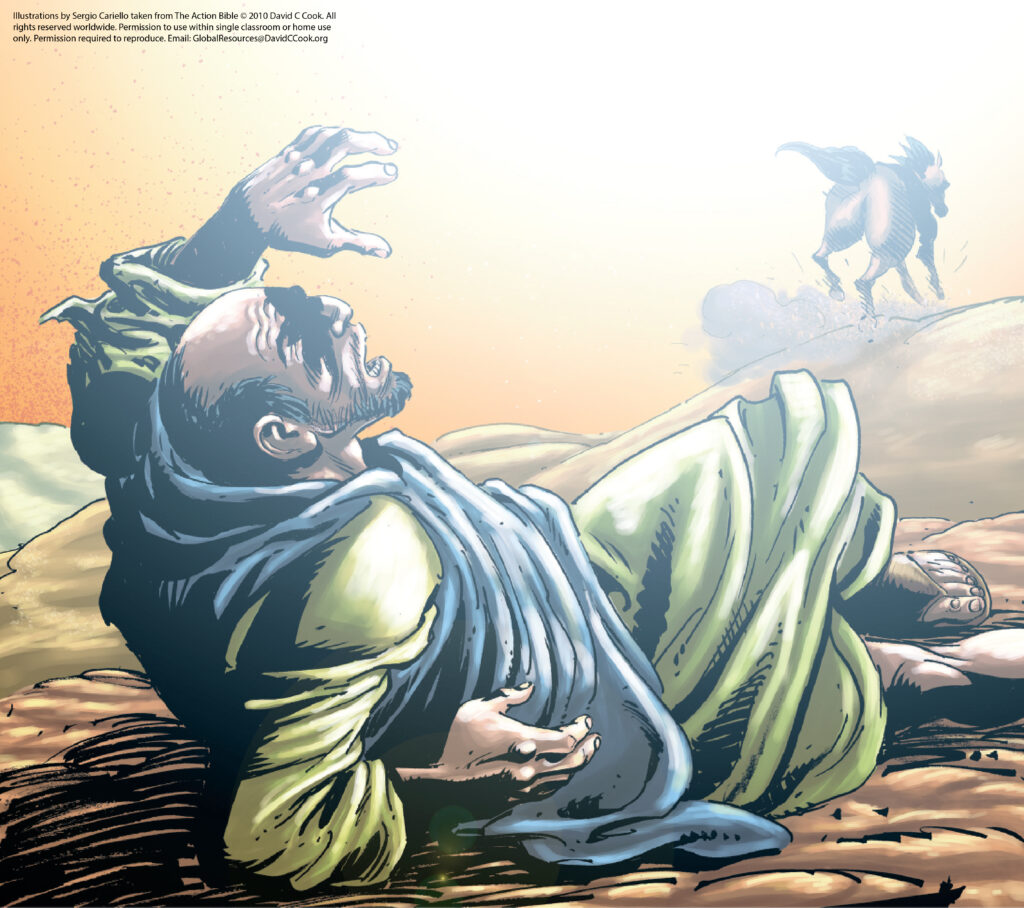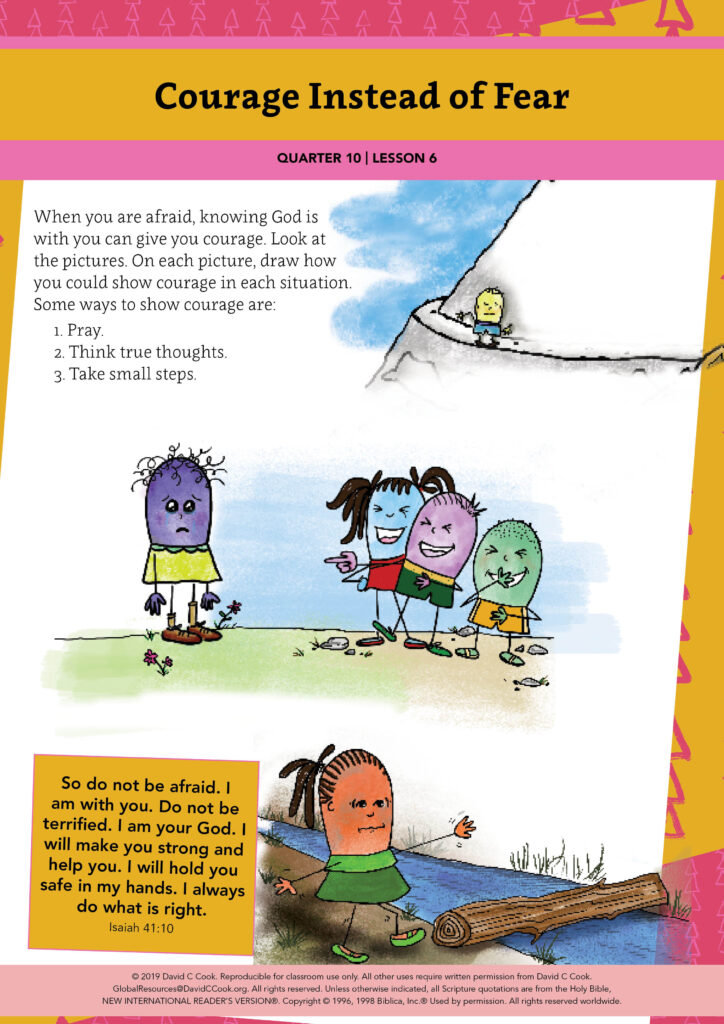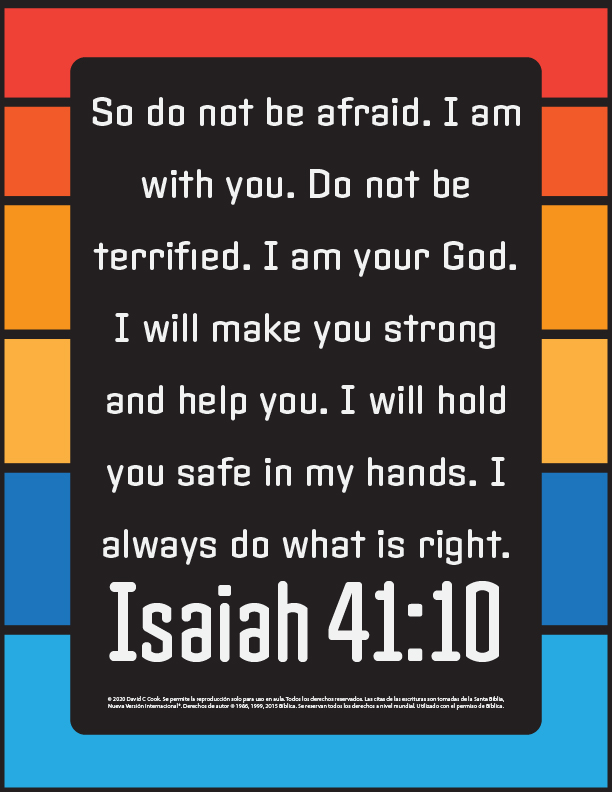During the lesson, the information for you to know is written in regular type, and what we suggest speaking or reading aloud to children is in bold. All resources for this lesson, including the Teacher Guide, Student Page, Family Connection Card, and other resources can be downloaded in a ZIP file by clicking on the following link:
In some lessons you will find "resource articles." These are articles written by experts from around the world to help equip you for your work with children and adolescents. Share them with parents or guardians if you consider it appropriate.
Before class, prepare 3 bags, each with different textured items. For example, you may place sand in 1 bag for a rough texture and grass in another bag for a smooth texture. Try to avoid food, fur, and feathers since the children will need to wash their hands after touching these.
When I’m afraid, I put my trust in you.
Psalm 56:3
God makes us strong! God also gives us courage when we are afraid. When we do what is right and honouring to God, we have nothing to fear! God gives us the courage to do things we could not do alone. When we pray and ask for His help, He is there to guide us through scary and difficult situations.
Have you ever been so afraid of something you could not move? Fear can be very powerful. But courage is far more powerful! God is the source of courage. Let Him take control of your thoughts and your fears. When you surrender these to God, He will help you overcome the fears that do not belong in your life. Surrender to God and rejoice in the fact He has control over your life. Give Him the glory for who He has created you to be.
Encourage families to talk to their children about fears that help them stay safe and fears that are not necessary. You could suggest that an adult list many different fears and have the child respond with a reason why each fear is helpful or not helpful.
Teacher Tip: If possible, email or text the Family Connection Card to the families of your students.
Greet the children as they come to class. Ask them to sit in 3 groups.
Let’s begin today with an activity that requires courage. I have 1 bag for each group. Inside each bag is an item, but I cannot tell you what it is. Anything could be in the bag!
In a moment, you will pass a bag around to each child in your group. You will feel the objects and try to figure out what is in the bag. You will not look in the bag and you will not say out loud what you think the item is. You will have just a few moments to feel what is in the bag before passing it to the next person in your group.
Do not allow the children to see in the bags. Give each group 1 bag. Have the children in each group pass their bag around the circle. When it is her turn, have each child stick her hand in the bag. Once all the children have touched the items in their bags, have the groups guess what their items were. Ask each group to report what they thought was in their bag. Then allow them to look in the bag.
Allow 2–3 children to answer the following questions.
Were you afraid to reach into the bag? Why or why not?
Students may talk about the fear of not knowing what was in the bag. They may also talk about trusting that you, the teacher, would not harm them.
If someone you did not know asked you to do the same activity, would it be safe for you to do this? Why do you think this?
The children may respond that they would do the same activity with a stranger, as long as that person was in the church. They may not want to do the activity with a stranger.
It is important to learn when to listen to fear and when to have courage. Our fears are often warning signs that help to keep us safe. When they are warning signs, fears are good. For example, a fear of heights would be healthy if you were on the edge of a cliff. However, if you were climbing a mountain on a wide path that was completely safe, you would not need to be afraid. When you do something you are afraid to do, you show courage. We learned last week that God gives us courage when we trust and obey Him. Let’s learn more about courage.
Have the children stand in a circle.
Optional: If possible, share the image from The Action Bible.

The Bible tells the true story of a very important and respected Jewish man named Saul. Saul did not believe Jesus was the Saviour of the world. Saul did not think Christians honoured God because they talked about Jesus being the Saviour. He began a journey to the city of Damascus to arrest the Christians living there.
On his way to Damascus, Saul saw a bright light and fell to the ground. Let’s pretend we just saw a bright light. Fall to the ground with me.
Fall to the ground with the children. Then look up.
Then Saul heard a voice from heaven. Listen to what happened:
If possible, read these verses directly from your Bible.
He fell to the ground. He heard a voice speak to him, “Saul! Saul! Why are you opposing me?” “Who are you, Lord?” Saul asked. “I am Jesus,” he replied. “I am the one you are opposing. Now get up and go into the city. There you will be told what you must do.”
Acts 9:4–6
When Saul stood up, Jesus was gone and Saul could not see! Everyone, close your eyes and imagine what it would be like if you could not open them. Keep your eyes closed as I tell the next part of the story. The men traveling with Saul led him into Damascus. He was blind for 3 days! You may open your eyes.
What emotions do you think you might feel if you were blind for 3 days?
Possible answers include: scared, angry, sad, and confused.
I might be scared and confused not knowing why I could not see. Saul needed courage to wait to discover what might happen next. Saul was not the only person in this true story who needed courage.
At that time, in Damascus a believer named Ananias had a vision of the Lord who told him to go to Saul. God would use Ananias to help cure Saul of his blindness. Ananias was not sure about what God had asked him to do. He said he had heard of the bad things Saul had done to God’s people. He knew Saul had come to Damascus to arrest believers. Listen to how God replied to Ananias’ concens:
But the Lord said to Ananias, “Go! I have chosen this man to work for me. He will announce my name to the Gentiles and to their kings. He will also announce my name to the people of Israel. I will show him how much he must suffer for me.”
Acts 9:1–16
Ananias did exactly as God had asked, even though he had heard that Saul had done many things to hurt Christians. Ananias went to Saul. Stand up with me and walk around the circle. When you get back to where you started, sit down again. Ananias laid his hands on Saul and prayed for him to see again. When Saul could see again, Ananias baptised him.
Do you think Ananias showed courage in going to Saul? Why or why not?
Allow 2–3 children to respond.
Sometimes courage looks easy from outside of a situation. In the case of Ananias, those of us sitting here today may think it was easy for him to do as God asked. Let’s think for a moment about what a similar situation would be like for you or me.
Close your eyes. Imagine someone your friends and family do not like. This could be someone who is unkind to you or your family, or this could be a child no one speaks to at school. Now, imagine yourself helping this person put a bandage on a hurt knee. Then you invite this person to dinner with you at your house. Open your eyes.
Do you think it would be easy to help someone who your family does not like? Why or why not?
Allow 2–3 children to respond.
Sometimes we may know the right thing to do, but fear and doubt may still fill our minds. Listen to what God says in the Bible about choosing not to fear.
So do not be afraid. I am with you. Do not be terrified. I am your God. I will make you strong and help you. I will hold you safe in my hands. I always do what is right.
Isaiah 41:10
There is a difference between doing what takes courage and doing what is foolish. If you are scared of doing something that is not helpful or kind, or if you think you might get hurt, it may be because this is foolish. However, when you act out of courage to do something kind or helpful, you can trust that God will be with you, even when you are scared. God always does what is right. You can trust that! Even when you get hurt or something bad happens to you, know God is there to help you.
Here are some tips to help you choose courage instead of fear:
Have the children stand and do the motion for each tip with you.
Let’s retell the story of Saul and Ananias. This time, we will stop and talk about which tip the men may have used to show courage instead of fear.
Saul was walking along when he saw a bright light and heard the voice of Jesus. Jesus told him to go to the city and wait for more information. When Jesus left him, Saul could not see!
What tip could Saul use to show courage?
He could think true thoughts about who just spoke to him. He could also pray and ask God for help.
Saul was led by some men into the city where he waited for 3 days. At the same time, a man named Ananias was told by God to go to Saul. He was asked to help Saul to see again.
What tip could Ananias use to show courage?
He could think true thoughts and recognize God told him it would be okay. He could take small steps to get to Saul.
Ananias went to Saul. Once there, he helped him to see, and he baptised Saul.
What tip did Ananias use to show courage in helping Saul?
He thought about the truth God explained to him that Saul would be used to do His work. He took small steps to follow what God asked him to do.
Both Ananias and Saul showed courage. They did this by listening to God and doing what He asked them to do. We can show courage by praying, thinking about the truth, and taking small steps to do things that are difficult.
Invite all of the children to sit at 1 end of the teaching space. Create an open area in the space where children can play the game safely.
Let’s play a game to help us practice having courage instead of fear. Think for a moment about something you are afraid of that you need courage to face. Maybe you are afraid of the dark. Perhaps you are afraid of talking in front of a group of people. Maybe you are afraid to care about someone because other people you have cared about have left you. Think of a fear.
Pause for 30 seconds to allow the children to think of a fear.
In a moment, you will all run from one side of our space to the other. I will choose 2 children to run after you to try to tap you on your shoulder or back. If you are tapped, you will stop where you are. You will not be able to move from that place until you call out 1 way you can choose courage instead of fear.
If you are afraid of the dark, you might call out, “I will pray to God to give me courage.” If you are afraid of talking in front of the class, you could call out something like, “I will answer 1 question in front of the class.”
Once you have called out a way you will choose courage instead of fear, you can run again. When you reach the other end of our space, you are safe and cannot be tapped by the 2 children running after you.
Choose 2 children to run after the other children. Remind these 2 children to try to gently tap the other children on the shoulder or back. Remind the other children to stop in place when they are tapped.
Ready? Go!
You may need to remind the children who are tapped to stop in place. You may also need to remind them to call out a way to choose courage instead of fear, and then continue running. Once all of the children have made it to the other end of the space, choose 2 new volunteers and play again. Allow the children to play for about 5 minutes.
Optional: If you are using Student Pages, give each child a crayon and allow the children to match each fear to a way to show courage.

You all had some great thoughts about how to choose courage instead of fear. Remember, you can take small steps to get through your fears. Or you can think true thoughts. Most importantly, you can always pray to God for help with your fears. Our memory verse today reminds us God can help us to choose courage instead of fear.
If you are using the Memory Verse Poster, show it to the students.
So do not be afraid. I am with you. Do not be terrified. I am your God. I will make you strong and help you. I will hold you safe in my hands. I always do what is right.
Isaiah 41:10

Have everyone stand. Sing or chant this verse using the following motions.
Have the children sing or chant with you. Repeat the words to the memory verse 3 times. Then end class by saying this blessing, based on Isaiah 41:10, over the children.
Blessing: May you know you are not alone in your struggles. May you trust in God to be with you when you are afraid. May you trust that God always does what is right.
Lead the children in singing this quarter’s song, if possible.
Life on Life ©2020 David C Cook. Reproducible for home or classroom use only. All other uses require written permission from David C Cook [email protected]. All rights reserved.